


The Government of Meghalaya with financial help from the World Bank is implementing the Meghalaya Community Led Landscape Management Project (MCLLMP). The project will cover the entire state of Meghalaya and implementation of community led plans will be rolled out in phase manner throughout the state. The Meghalaya Basin Management Agency (MBMA) will facilitate community-led planning by providing support, technical inputs and funding.
The project is intended to strengthen community-led natural resources management in selected landscapes within the 11 districts of the state. This would be achieved through a variety of planning, capacity building, and on-the-ground interventions to promote the conservation, sustainable use of natural resources, social inclusion and community mobilisation; building traditional knowledge and learning, mapping of natural resources management; strengthening the community institutions and creating linkage with financial institutions and community organizations.
The project interventions include preparation of community led natural resource management plans. The CLLMP has the following three components:
Strengthening Knowledge and Capacity of Communities for Natural Resources Management
Community-Led Landscape Planning and Implementation
Project Management and Governance

The project objective is “to manage and conserve the natural resources, especially forests, soil and water sources, in a manner that supports the financial and physical well-being of communities in the State”
The CLLM-Programme focuses on increasing the capacities of communities and traditional institutions (TI) by adopting a landscape approach to manage their natural resources such as soil, springs and other water sources, forests and bio-diversity, etc.
The project will be planned and implemented in about 400 villages across the state.
CLLMP has a strong focus on institution-building at the village-level, by ensuring systematic capacity-building on technical and social skill-sets.
The project will also extend such training to communities beyond the targeted villages and support efforts made by them to access funding from various rural and natural resources initiatives and schemes.
The programme will also invest in improving the process and outcome delivery, by developing and adhering to effective systems and procedures, supported by the appropriate technology.
Benefits for community (Skills and Capacity relating to technical and managerial areas like NRM and Conflict resolution
Benefits to traditional institutions (village councils, traditional leaders, community-based organizations, SHGs etc) through Knowledge sharing, promotion of innovative approach, access to technology, technical managerial and financial support.
It is estimated that the project will impact around 1 lakh partners (of which 50% are women) who depend on land, forest, agro forestry.
Through the project, 55000 Ha of targeted area will be ensured with availability of water, biological resources and soil productivity, which will in turn benefit around 400 villages and the outcomes delivery can be summarized as follows.
The Project is executed by the MBMA in collaboration with other partners particularly, SIRD (for training and capacity building), Department of Soil and Water Conservation, Water Resource Department, Forest Department, specifically with respect to technical inputs, safeguards management and Community NRM plan preparation
2018-2023 (5 years)
Introduction
Nonglum Village falls under Jirang C&RD block of Ri-Bhoi district in the state of Meghalaya. It is only 1km from the C&RD block .The village is at a distance of 72 Kms from Nongpoh, the district headquarters of Ri Bhoi District and is at a total distance of 128 Kms from the state capital, Shillong.

History of Nonglum Village, New Jirang Ri-Bhoi District
Nonglum village is one of the 6 villages that form up New Jirang and is located in the South. It was founded on 09/05/2002 by Shri Sevenman Thangkhiew an Elder of the King’s Durbar who was given authority by The Syiem of Jirang (L) Shri. Lokendro Syiem and it then consisted of only 15 households.
As there were no roads connected to the village a footpath was constructed in the year 2004-05 with the help of the then MLA Shri. J.D.Rymbai. In the same year 7 platforms to provide water were constructed by the PHE department to supply water to the village. The MGNREGA scheme was started in the village in the year 2007 and through this scheme the village was able to construct footpaths and also an unpaved road which leads to the village. As the village is growing in size and population therefore various government offices like the Block office (Jirang C&RD Block), the District Council, and Social Forestry have provided assistance with the construction of footpaths.
In the year 2010 the Social Forestry department has taken the initiative for the development and preservation of the village Catchment area for 5 years, apart from assistance with the construction of footpaths it has also helped the village with digging of a well to supply drinking water to the villagers. The PHE department on top of providing water to the village further assisted 25 households in the village in the construction of pit latrines in the year 2012. The MESEB department helped 25 households to receive electricity connections in 2012 to 25 households through the BPL scheme.
The village got a SSA L.P school in the year 2007 and an Assam type building was built for the school in the same year. Due to the growing number of students and households in the village the Office of the School Education Officer, Nongpoh helped in the construction of a bigger and better building of which the construction was started in 2013 and completed in 2018. In the year 2016 the E.E. Water Resource, Nongpoh Division enlisted the village in the “Jal Kranti Abhiyan” project and this office has helped to construct 3 wells and a spring to provide drinking water to the village. The office of the Deputy Commissioner Ri-Bhoi District granted the village with 8 solar powered street lights in the year 2019 through the Rural Development Agency Ri-Bhoi district. The office of the BDO Jirang C&RD Block helped 27 economically weaker households build their homes from 2009-2019.
With the inclusion of the Jirang C&RD Block Office and other offices under the area of the Block the number of houses in the village reached 63 houses in the year 2019 and the village was enlisted in the working Programme of BASIN through CLLMP and development was started with the construction of Vermicomposting sites in the year 2020.
The PHE further participated by building latrines for 38 individual households till the year 2020, and a survey was also done to supply drinking water to each and every household through the JJM scheme. The village is trying to construct a cemented road through MGNREGA as there is no PWD road.
Social Profile
The total number of households is 61 and has a population of 215 people. Most of the people are engaged in Agriculture allied activities , where some few others are also enrolled in government servants .
Village Accessibility: In order to reach Nonglum village, one must venture through the Umling and Jirang P.W.D. a road laying 1 km from the Block Headquarter and lying 70 KM far away from District Headquarter one who wants to venture through Nonglum village they have to venture from Jirang road and to the left lying one kutcha road and through that road one can reach the village.
Literacy: As per the 2011 census, the village literacy rate has touched to the tune of 78% in which it is higher than Meghalaya literacy rate is 74.43% as of 2011 Census the Male literacy rate of Nonglum village stands at 83.82% while female literacy rate was 71.88% .
Presently the village is run, managed and guided by its active Durbar as the highest authority in the village which is alternatively comprised of the Seng Kynthei, (Women Wing) Seng Samla (Youth Wing) and Village Defence Party (VDP) all collectively aiming for the overall good and growth of the village. Other committees such as (1)Village Employment Council (VEC) (2)Village Health Sanitation and Nutrition Committee (VHSNC) (3)Village Level Coordination Committee (VLCC) (4)Vigilance Committee, (5) Village Water and Sanitation Committee (6) Village Forest Fire Control Committee are constantly active and vigil as well, working in due co-operation between themselves for a brighter tomorrow of the village.
Population 
As per Census 2011, Nonglum population is 215. Out of this, 107 are males while the females count is 108 . This village has 28 children in the age group of 0-4 years. Among them 11 are boys and 17 are girls.
| Age Group | Male | Female | Total |
|---|---|---|---|
| 0-4 | 11 | 17 | 28 |
| 5-14 | 31 | 30 | 61 |
| 15-30 | 28 | 29 | 57 |
| 30-60 | 32 | 27 | 59 |
| Above 60 | 5 | 5 | 10 |
BPL/APL Household:
| Particulars | No. of HH |
|---|---|
| BPL HH | 41 |
| APL HH | 20 |
Card Holding Household:
| Particulars | No. of HH |
|---|---|
| Total HH | 61 |
| Ration Card HH | 61 |
| Health Card HH | Nil |
Fuel Type:
| Fuel Type | Total HH |
|---|---|
| Charcoal | 0 |
| Biomass | 0 |
| Wood | 41 |
| LPG | 04 |
| Electric Heater | 0 |
| Kerosene | 01 |
OCCUPATION:The people of the village rely on
agriculture and forest products for their livelihood. The main
occupation of the villagers is farming followed by Masons and
Carpenters ,and some other Government Servants.




CLLMP ACTIVITIES
Ground Truthing Dated: 3rd of July 2020
The CLLMP team met with Mr. Pinkisno Kalwing, the headman of Nonglum Village on the 3rd of July 2020, who was able to provide the team with the required details for site verification.

Figure 1 : Ground-truthing at Nonglum Village.
Case Findings & Selection parameters: -
1. There are 61 Households out of which 41 Households fall under the BPL category.
2. VEC actively performing.
3. Approximately 20-25 acres of community forest available.
4. Scope for Water Sources to be developed
5. Need for Community Nursery and Vermi-Compost
5. The Community members expressed their need for Drinking Water.
The Village has been selected under the Community Led Landscape Management Project
2. Sensitization Programme Dated : 03.07.2020
The District Project Manager and the Assistant Managers held a village Level sensitization Programme on the Community Led Landscape Management project on the 3rd,of July 2020.The community members actively participated in the program, voicing out their concerns and questions regarding the project making it a huge success. A total of 25 community members attended the program out of which 15 are female (Due to COVID restrictions there were few participants during sensitization program.
The CLLMP officials gave a brief introduction on Meghalaya Basin
Management Agency (MBMA) and explained about the various programmes
and projects that MBMA is working on, they then gave a detailed
introduction on the Community led Landscape Management Project
(CLLMP) and the different aspects and procedures that the villagers
and the CLLMP team should carry out during the course of the project
and the importance of the involvement of the community for the
CLLM-Project to be a success. They gave due importance on the
environmental aspects of the project and enlightened them on the
various benefits that the villagers could obtain from the
project.
The Program was followed by an interactive session to answer the doubts and questions of the villagers some of which are mentioned below.
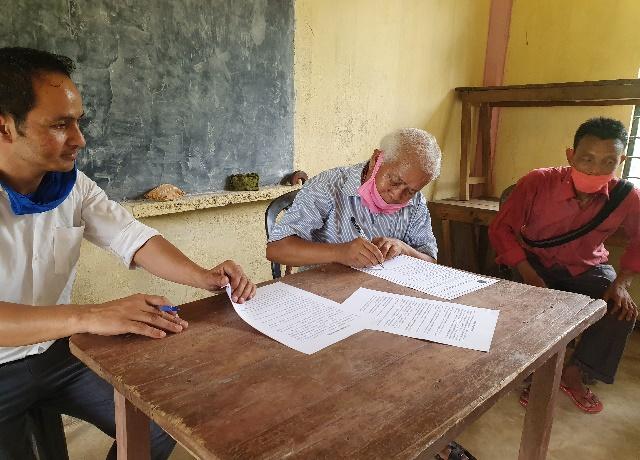
2.2 Signing of Documents:
After the interactive session, the village signed the EOI, VGA and Green charter followed by the selection of candidates for the Village Natural Resource Management Committee. The Village Executive Committee (VEC) and the entire community carried out the procedure and elected the members of the VNRMC on the same day.
2.3 Formation of the VNRMC
The Formation of the Village Natural Resource Management Committee was done in a public meeting in the presence of the entire village and the CLLMP staffs. The community itself chose the President, the Secretary and the other executive members of the Committee.
Listed below are the members of the VNRMC:
|
|||||||||
|---|---|---|---|---|---|---|---|---|---|
|
Name | Designation | Gender M/F | Age (Yrs) | Education | Occupation | Community | Religion | Contact No |
|
Stailar Nongphlang |
President | M | 35 | VIII | Mason | Khasi | Christian | 9862174031 |
|
Pynshaisngi Thangkiew |
Secretary | F | 24 | X | House wife | Khasi | Christian | 8730845740 |
|
Osrtarman Lyngdoh | Book keeper | M | 45 | IX | Carpenter | Khasi | Christian | 9612360474 |
|
Luminos Thangkiew | Member | F | 40 | V | Farmer | Khasi | Christian | 7628939757 |
|
Shemlus Wahlang | Member | M | 48 | II | Farmer | Khasi | Christian | N.A |
|
Kyrshanbor Ranee | Member | M | 45 | VIII | Farmer | Khasi | Christian | N.A |
|
Shantina Wahlang | Member | F | 27 | II | Farmer | Khasi | Christian | 6002608920 |
| Lolita Sangma | Member | F | 45 | Farmer | Khasi | Christian | 8731002221 | ||
| Armystar Thangkiew | Member | M | 26 | XII | Farmer | Khasi | Christian | 8837083928 | |
| Village Community Facilitators | |||||
|---|---|---|---|---|---|
| Name | Gender | Age | Education | Contact Number | Role |
| Ostarman Lyngdoh | M | 45 | lX | 7628940137 | EM&GIS |
| Banrilang Thangkiew | M | 20 | lX | 7005485455 | PM- M&E |
| Ithabashan Sangma | F | 28 | X | 8732086676 | Social Management |

Fig : The Village Natural Resource Committee(VNRMC) of Nonglum village
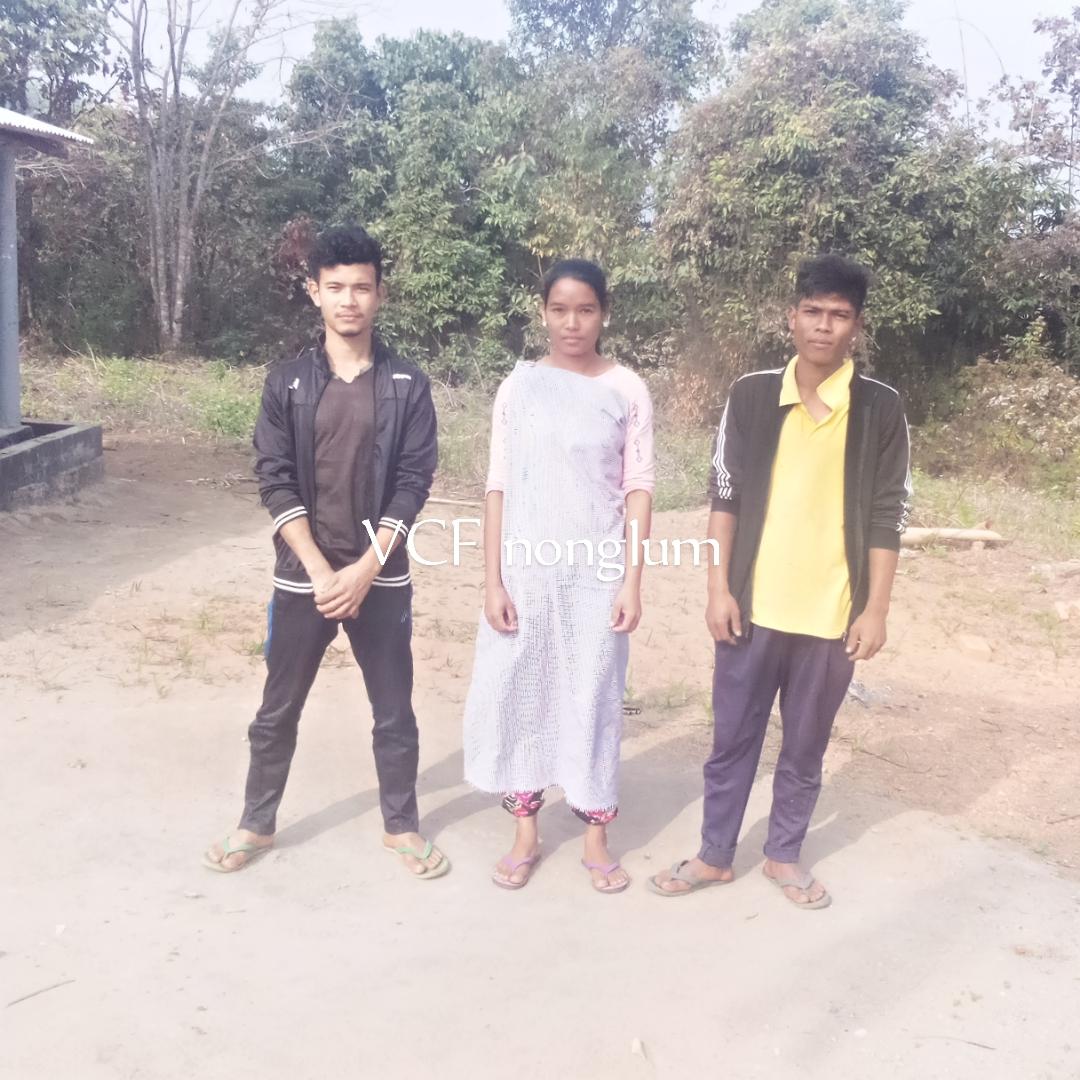
Fig : The village committee Facilitators of Nonglum village
3. Opening of a Bank Account.
The opening of the bank account was initiated after the village signed the EOI (Expression of Interest), the VGA (Village Grant Agreement) and the Green Charter. Nonglum village opened their VNRMC account on the 30th of June2020.
External expert of accounts on 17.03.2021 impartedtraining on this topics:
1. Detail bookeeping to bookeeper and secretary
2. FQ and procurement to purchase committee
3. Transfer credit advice
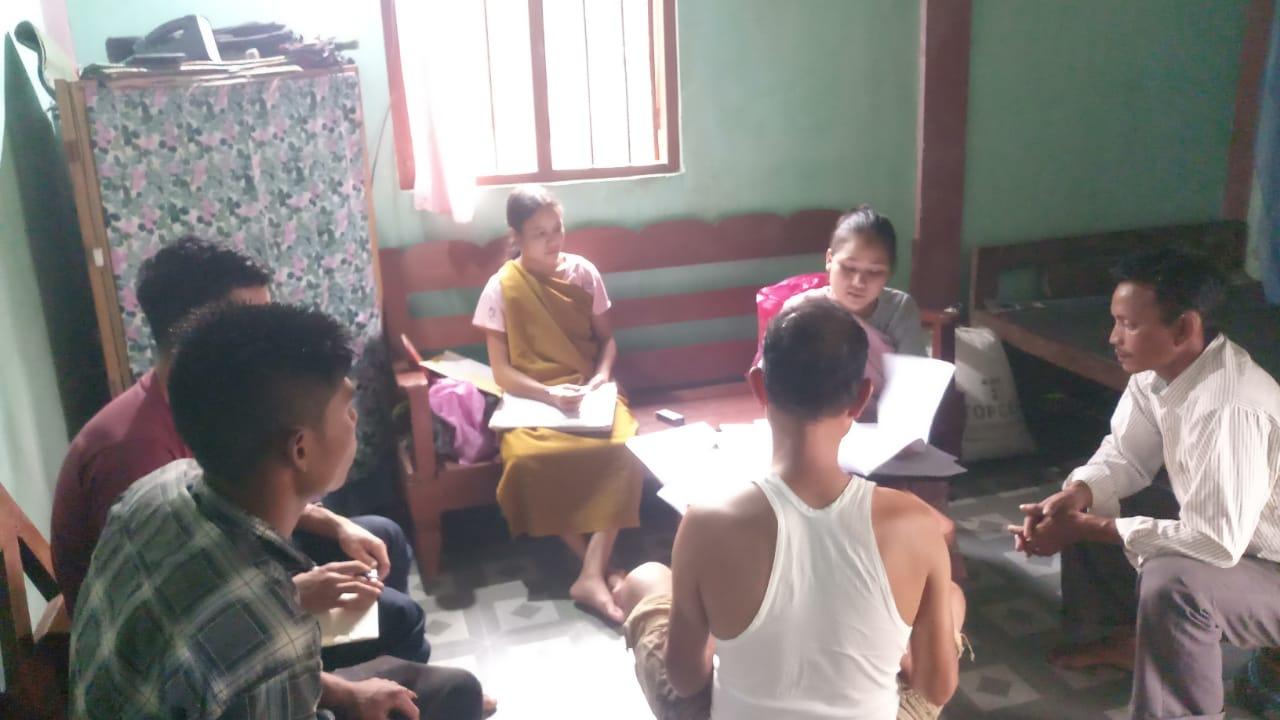
\
The Accountant of CLLMP Team Ri Bhoi District trained the Purchasing and Procurement Committee of Nonglum Village on the 19th of August 2020.
Topics Covered:
Principles of Community Procurement
Benefits of Community Procurement
Important aspects undertaken by Community Procurement.
Procurement Process/Steps
Function of Purchase Committee
Important Procurement records to be maintained
Financial limits and methods

4. Participatory Rural Appraisal Exercise
17th – 21st August 2020
PRA exercise at Nonglum Village took place from the 17th to the 20th of August 2020. There were a total of 89 villagers taking part in this exercise who contributed their time and knowledge to this project.
17.08.2020. (Day 1: Re-Orientation on CLLMP and Discussion on CNRMP)
On the 17th of August 2020, the Deputy Project Director of NRM under the CLLMP, and the General Manager, Knowledge Management, along with the DPMU team organized a reorientation program on CLLMP.
The initial stage of Participatory Rural Appraisal (PRA) exercise at Nonglum Village, commenced with a meeting cum orientation program on CLLMP. While conducting the meeting, the community members were made aware of the various PRA exercises to be conducted for the development of the Community Natural Resource Management Plan (CNRMP) of the village, the community members’ contribution in the exercise and the objectives to be achieved. The key informants (the VNRMC and the VCFs) helped facilitate maximum participation. The dates and time for conducting the various Participatory Rural Appraisal (PRA) exercises were fixed in consultation with the community members and all were requested to participate in the exercise. The schedule and time was announced at the end of the meeting.
The Deputy Project Director (NRM) of the Community Led Landscape Management Project discussed the different types of plans that can be adopted by the village and stressed on the need for more holistic and sustainable plans which will benefit the community as a whole.
Commencement of PRA.
Introduction: Participatory Rural Appraisal (PRA) is the process of involving local people in the analysis and interpretation of their own situation of a given rural area. The local people i.e. the participants take a leadership role in collecting, analyzing, interpreting and presenting information and in this process impart knowledge and development insight to the specialists and extension agents
For management of natural resources, participatory Rural Appraisal is conducted to establish rapport with the village community as well as to identify and define problems for prioritization in the village itself. It is a way of learning from and with community members to investigate their need assessment, analyze and evaluate constraints and opportunities and find out priorities in the area of agriculture, small scale rural enterprises and any other social and economic development programs addressed to village development. Based on the principle of listening and learning,
Objectives of PRA exercise at Nonglum Village:
The Participatory Rural Appraisal (PRA) exercise at Nonglum was conducted with following objectives:
To identify the natural, human and economic resources of a village.
To identify the village problems and prioritize them with the help of the community members.
To prepare the Community natural Resource Management Plan of the village.

Activity 1: Village Boundary Mapping:

Activity 2: Drawing the Resource Map
The second step is to involve the local community in preparation of a village resource map as perceived by the community members to solicit their participation. Infrastructure, services and other village resources such as agricultural lands, wells, wastelands, cattle population etc. were mapped. Local people prepared the Resource Map by drawing it on a chart paper without much interference from outsiders.

This activity achieved the following purposes:
Rapport building and winning the confidence of the villagers.
Analyzed the spatial information, particularly studied problems and opportunities of villagers.
Got an impression about the village setting, physical layout, location of various houses and institutions.

Findings Based on the Resource Map of Nonglum Village:
Main agriculture produce is Paddy and orange fruit
There is 1 type of Forest ownership: 6 Community forest Owned.
Ten (10) springs are present in the village
One rivers flows in the north-eastern part of the village
Jirang block office is present
School: there is one lower primary school in the village.
There is one church
Habitation is confined to the north eastern part of the village.
Activity 3: Baseline Data Survey to fill the Environment and Social Template
Date:01/10/2020
During the PRA exercise, the CLLMP EE of Social Management and the community members were sitting together to fill the Social Templates.Discussions and consultations with social groups existing in the village was held to gather basic village information regarding no. of households, demographic information, major crops and enterprises taken in the village, trends of production and productivity of major crops in the village and demographic distribution of village population.
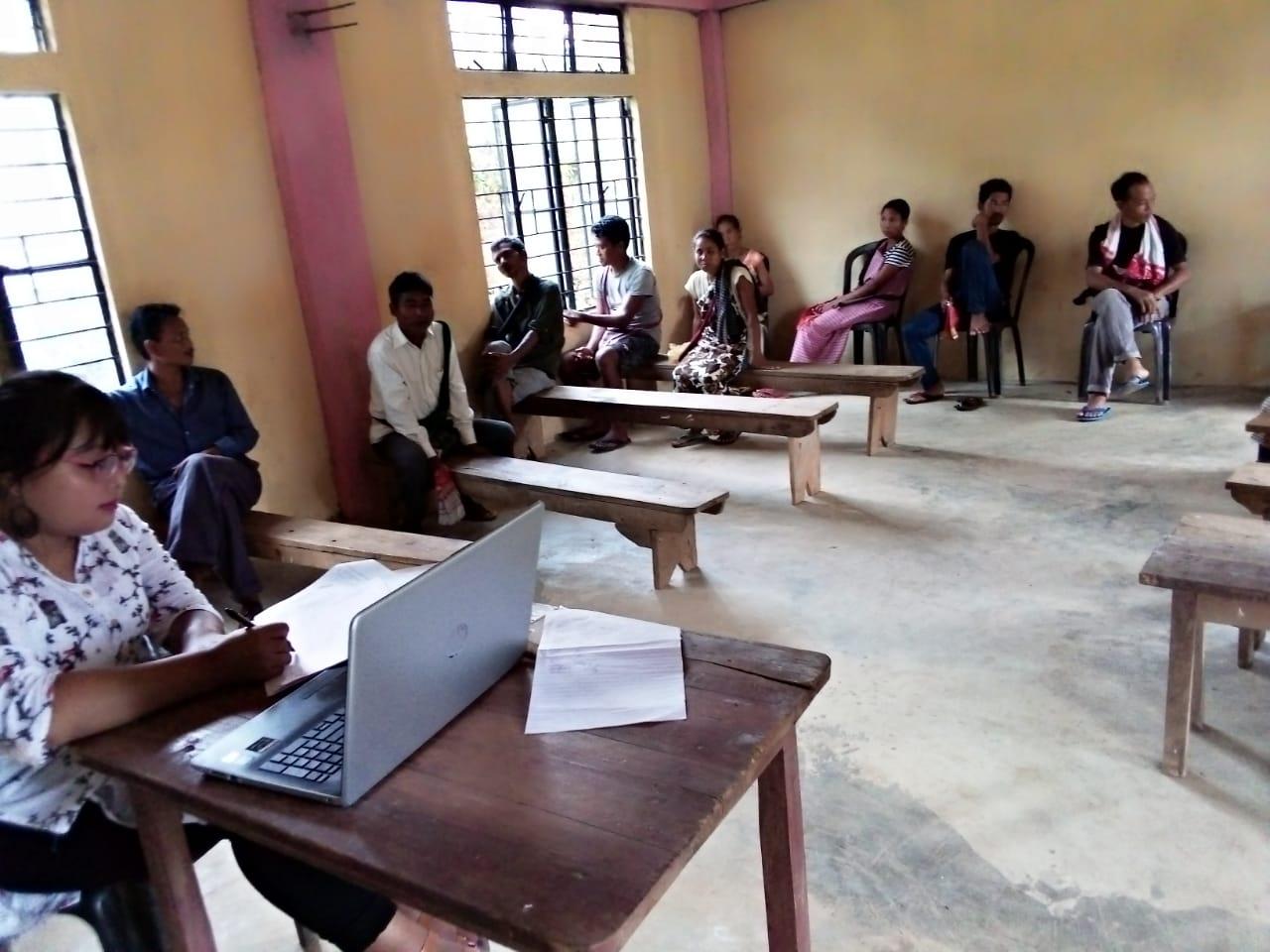
Informations related to land use category such as forest, cultivable land, water bodies ,etc were discussed with another group consisting External expert of environment management and the village community (who are quite aware of the village boundary and the presence of natural resources in the village) Problems related to NRM were discussed. Forest fire was one of the issue being discussed.
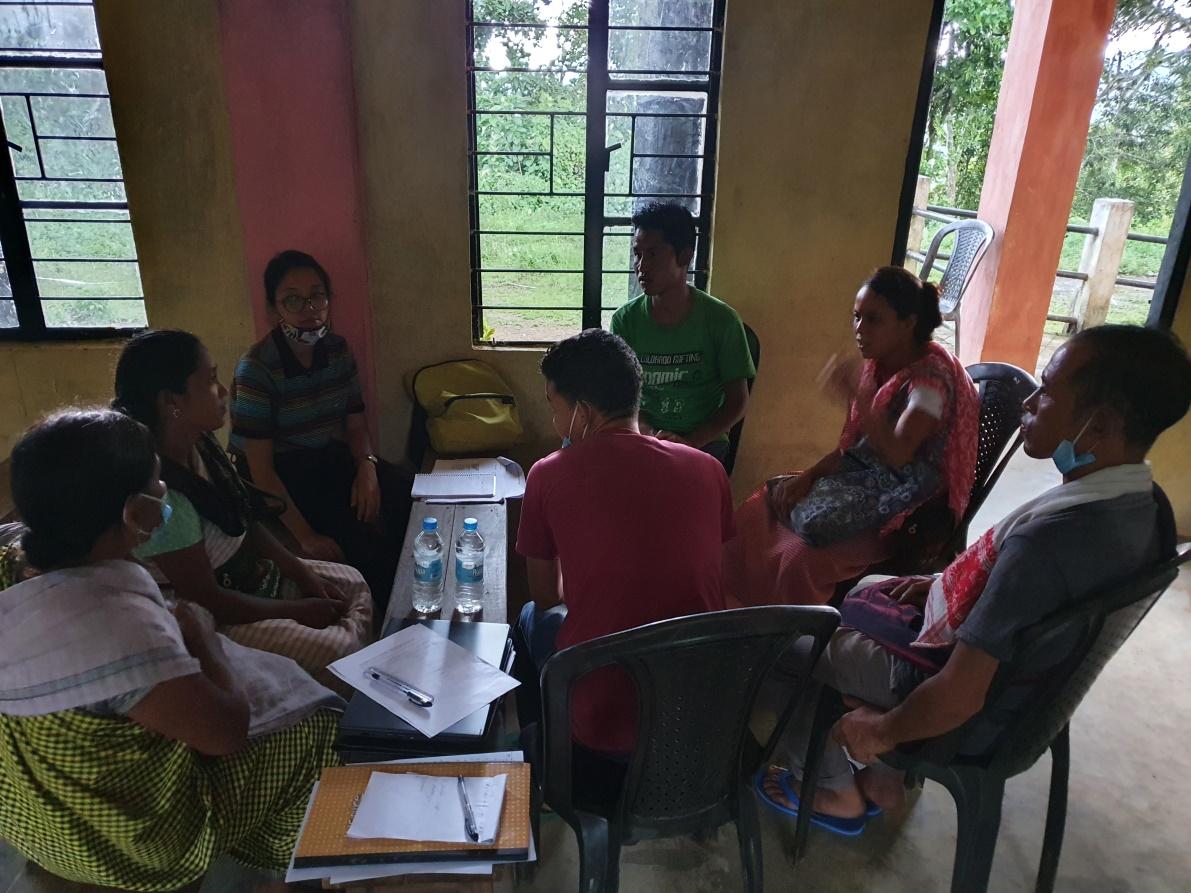
Activity 5: PROBLEM ANALYSIS
A. Do people have sufficient access to supply of fodder ,fuel wood, leaf litter?
yes, presently the villagers they said that they access sufficiently to fodder ,fuel wood and leaf litter and till now they have not face any issues regarding to this matter
B. Has access to timber improved or reduced over the years? How is access for household use and commercial use managed?
Yes, the Timber has been reduced as compared to other years but the villagers can still access it for household use and even they are used for commercial purposes so that they can improve their economy and livelihood status .
C. Are the Water bodies facing any threats?
No threats, but during rainy season the water becomes red and difficult to access for drinking and cleaning
D. Do all the people in the village have access to drinking water? What are the challenges?
Yes the Nonglum Village has access to drinking water through the P.H.E pipeline and the only challenges that they face is during dry season the volume of water gets reduced and is difficult to access .
E. Are there degraded areas in the village (open/degraded forests , mining affected ,high soil erosion etc)?
yes
F. What has caused this degradation ? Are there practices causing threats to availability and access to natural resources ?
due to shifting cultivation. No they are not causing any threat.
What have been the changes in agricultural practices?
They are still practicing Jhum Cultivation with no other changes but people after they finish paddy harvesting are engaged in crop cultivation and other household work like collections of fuelwood.
Are there any challenges in farming?
Yes they face a lot of challenges especially wild animals. They come and destroy all their paddy fields and also they eat and damage the crops so the farmers can not do anything and face a great loss.
How would you consider the health situation in your village?
The health situation at Nonglum they face a lot of problem regarding with the road situation because when there is anyone who falls serious illness they just have to carry the person at their back till they reach the proper road and access the vehicle till they reach the Dispensary or Hospital theirs no vehicle from within the village due to lack of proper road connectivity.
The dispensary is 7km from the village and CHC Patharkhmah is 5km from the village.
The ASHA plays their vital role in examining and monitoring the daily food supplements in the village and the ASHA said that the age group infants in the summer season suffer from diarrhoea but as compared to Malaria it has been reduced in these two years. So compared to other years the Health situation has improved.
How is the situation of cleanliness , sanitation access to toilets and waste management ?
Cleanliness in the village has been improved as compared to others years after the Swachh Bharat Mission came into force. Under this Mission in 2006 and 2009 , some Households in the village got access to the sanitary latrine through some scheme the cleanliness is the priority of the village. Awareness programmes used to conduct within the village.
Who is the most vulnerable group in the village? What can be done to improve their lives?
BPL Families . Inclusion of BPL Families during project implementation.
What are the livelihood aspirations of the youth ? Are there any avenues available?
The majority of the people in the village turn to farming and get a job card under MGNREGA for employment.
Do any committees /institutes/rules exist to manage and monitor natural resources in the village?
The VNRMC under the CLLMP will manage the Natural resources in the village . prior to the CLLMP the village received permission from the forest management committee to look after and preserve the forest. There are two community forests in the village Amshiongpuh its area is 3Hc and the other one is Krohamiong it is the forest which is run by the youth association of the village its area is 4Hc.
What are some of the major issues or conflicts in the village?
Till the present days the people of the village have no conflict or issues within or outside the village they live in a peaceful environment.
Have any of the above issues been discussed in village meetings?
If there is any issues or conflict within the village the Durbar shnong will solve the issues and address the Problems
How do people resolve disagreements and conflicts?
All disagreements and conflicts are addressed by the traditional institution of village governance called the village Durbar.
Activity 6: Seasonality Calendar
The CLLMP EE Social Management also mapped the seasonal calendar
of Nonglum Village to help identify heavy workload periods, periods
of relative ease, credit crunch, diseases, food security, wage
availability etc. This will prove helpful in project planning and
project timeline framing.
Figure : Preparation of Seasonality Calendar
Participants:
Shri. Stailar Nongphlang- VNRMC Member
Shri. Batskhembor Jamu- Village Community Facilitator
Shri. Banrilang Thangkiew- Village Community Facilitator
Shri. Ritingsos Lapang- VNRMC Member
Smt. Pynshai Sngi Thangkhiew- VNRMC Member
Smt. Banisha Rani - Village Community Facilitator
Smt . Shantina Wahlang- VNRMC Member
Smt . Lumino Thangkiew- VNRMC Member
| SEASONAL CALENDAR | |||||||||||||
|---|---|---|---|---|---|---|---|---|---|---|---|---|---|
| Sl No. | CRITERIA | JAN | FEB | MAR | APRL | MAY | JUNE | JULY | AUG | SEP | OCT | NOV | DEC |
| 1 | Water Scarcity | 2 | 2 | 1 | 1 | 1 | 3 | 3 | 3 | 2 | |||
| 2 | Prone to sickness | 3 | 1 | 1 | 1 | 2 | 2 | 2 | 3 | ||||
| 3 | Seeking job outside | 2 | 2 | 3 | 3 | 3 | 1 | 1 | 1 | 2 | |||
| 4 | Rain Fall | 3 | 2 | 1 | 1 | 1 | 2 | 2 | 3 | ||||
| 5 | Free – Less work | 1 | 1 | 1 | |||||||||
| 6 | Paddy Cultivation | 1 | 1 | 1 | |||||||||
| 7 | Paddy harvesting | 2 | 1 | 2 | |||||||||
| 8 | Ginger cultivation | 1 | 1 | ||||||||||
| 9 | Ginger harvesting | 2 | 1 | 1 | |||||||||
| 10 | Tree Plantation | 2 | 1 | 1 | 2 | ||||||||
| 11 | Vegetable (crop cultivation) | 1 | 2 | 2 | 1 | ||||||||
| 12 | Vegetable (crop harvesting) | 1 | 1 | ||||||||||
| 13 | Festive Season | 1 | |||||||||||
| 14 | Forest fire | 1 | 1 | 3 | 3 | ||||||||
| 15 | Collection of Fuel wood | 1 | 2 | 2 | 3 | 3 | 3 | 1 | 1 | ||||
| MAXIMUM | 1 |
|---|---|
| MODERATE | 2 |
| LESS | 3 |
List of NRM activities submitted by VNRMC
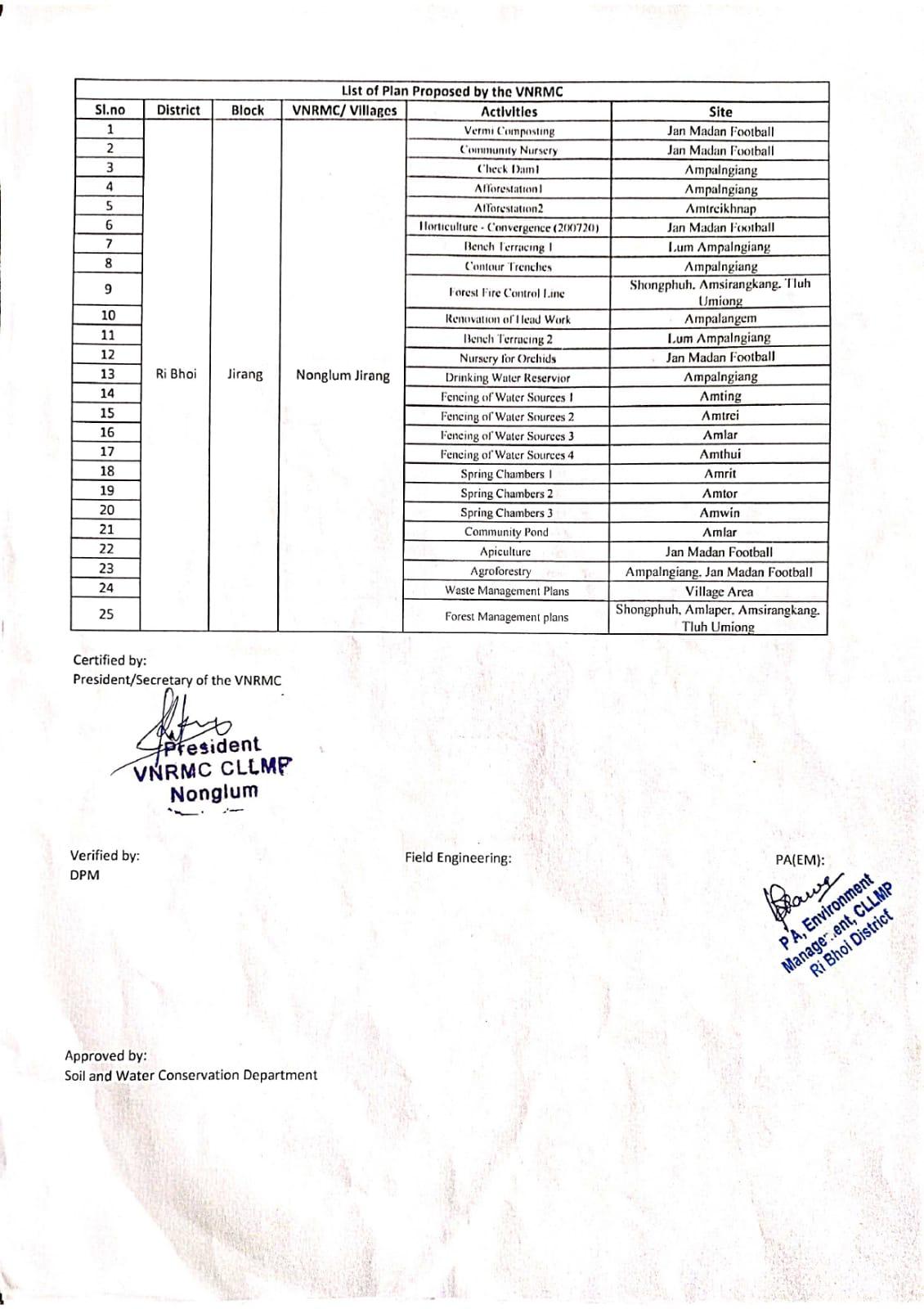
The Finalized Community Natural Resource Management Plan of Nonglum Village.
|
Name of Proposed Interventions | Site |
|
Nos of HHs expected to Benefit | ||
|---|---|---|---|---|---|---|
|
|
|
||||
| 1. | DRINKING WATER RESERVIOR | AMPALNGEM |
|
|
|
|
| 2. | NURSERY | Don Madan |
|
|
|
|
| 3. |
|
|
|
|
|
|
| 4. |
|
Ampalangem |
|
|
|
|
| 5. |
|
Ampalangem |
|
|
|
|
| 6. |
|
Umshongphui |
|
|
|
|
| 7. |
|
|
|
|
|
|
| 8. |
|
Dong Madan |
|
|
|
|
| 9. |
|
Dong Madan |
|
|
|
61 |
| 10. |
|
JAN MADAN FOOTBALL |
|
|
|
|
| 11. |
|
Ampalangem |
|
|
|
|
| 12. |
|
AMLAR |
|
|
|
|
| 13 |
|
|
|
|
|
|
| 14 |
|
|
|
|
||
| 15 |
|
|
|
|||
| 16 |
|
Dongsmowknor |
|
|
||
GIS Activities
| Sl.No | Parameters | Village Information |
|---|---|---|
| 1. | GPS Coordinates | |
| i | Latitude | 25.903467°N |
| ii | Longitude | 91.588458°E |
| iii | Elevation Reading (MSL) | 503 M |
| 2. | Village Geographical Area(Ha) | 406.30 Ha |
| i | Total Forest Area ( including community, Clan, Pvt Forest) | 322.38 Ha |
| ii | Total Area of Water Bodies | 0.14 Ha |
| iii | Total Area under Agri- Horticulture | 4.82 Ha |
| iv | Total Degraded land area (Ha) | 71.45 Ha |
| 3 | Average Annual Rainfall | 1000-1200 |
| 4 | Soil Type | Loamy soil |


| NAME OF THE INTERVENTION | SITE NAME | TOTAL AMOUNT | DATE OF COMPLETION | WORK STATUS |
|---|---|---|---|---|
| COMMUNITY NURSERY | JAN MADAN FOOTBALL | 2,95,000 | 17.11.2021 | COMPLETED |

| NAME OF THE INTERVENTION | SITE NAME | TOTAL AMOUNT | DATE OF COMPLETION | WORK STATUS |
|---|---|---|---|---|
| AFFORESTATION | AMPALNGIANG AMTREIKHNAP |
2,87,740 | 10.08.2021` | COMPLETED |
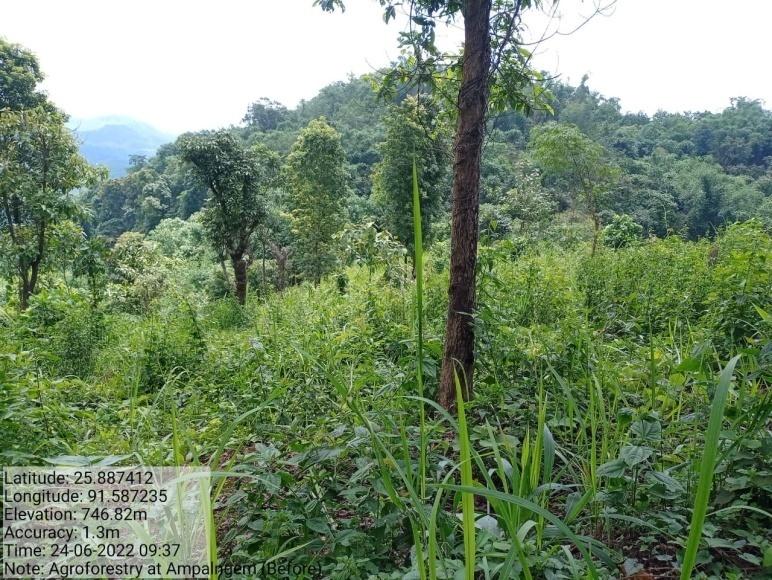


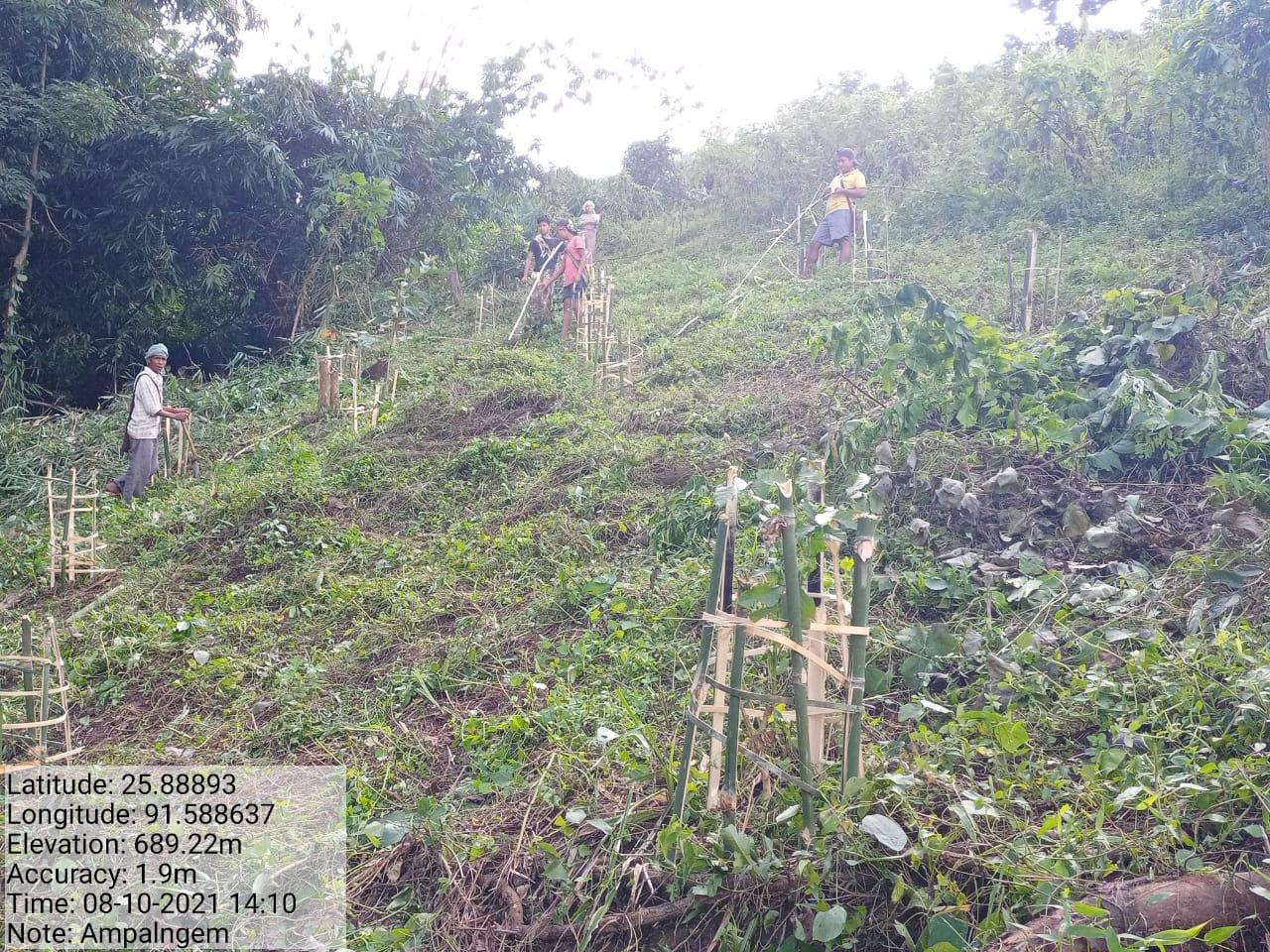
| NAME OF THE INTERVENTION | SITE NAME | TOTAL AMOUNT | DATE OF COMPLETION | WORK STATUS |
|---|---|---|---|---|
| VERMICOMPOSTING | JAN MADAN FOOTBALL | 3,32,460 | 2.12.2020 | COMPLETED |

| NAME OF THE INTERVENTION | SITE NAME | TOTAL AMOUNT | DATE OF COMPLETION | WORK STATUS |
|---|---|---|---|---|
| CHECKDAM | AMPALNGIANG | 4,57,000 | 31.01.2021 | COMPLETED |

| NAME OF THE INTERVENTION | SITE NAME | TOTAL AMOUNT | DATE OF COMPLETION | WORK STATUS |
|---|---|---|---|---|
| HORTICULTURE | JAN MADAN FOOTBALL | 65,120 | 12.08.2021 | COMPLETED |
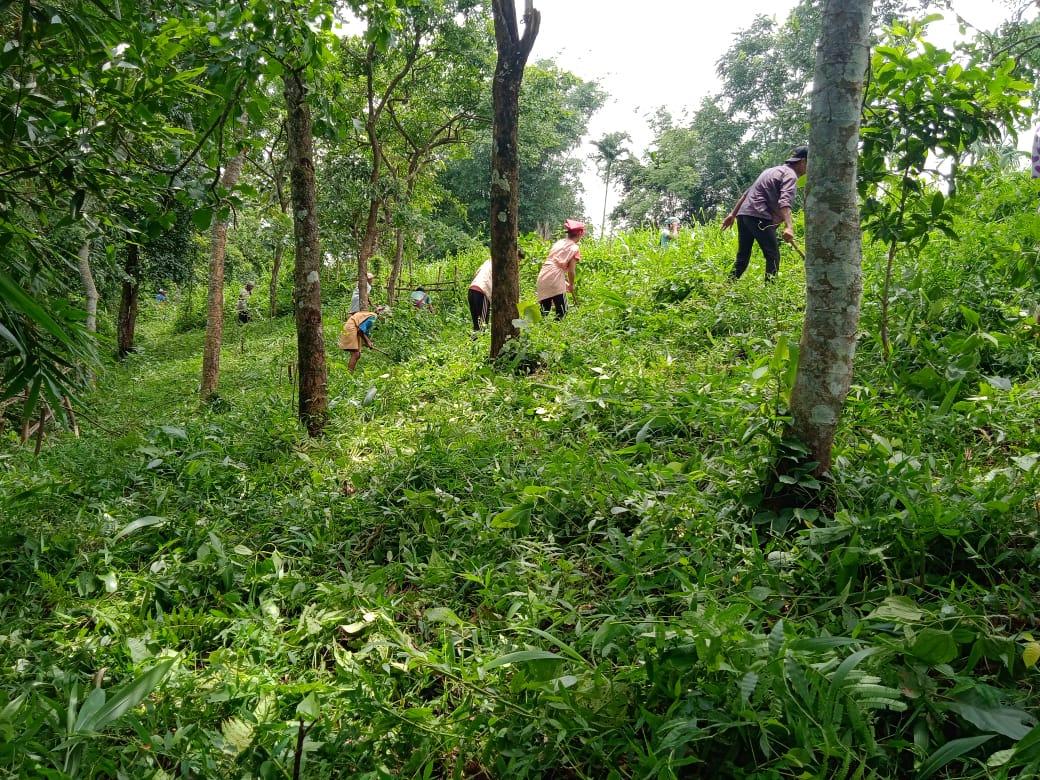
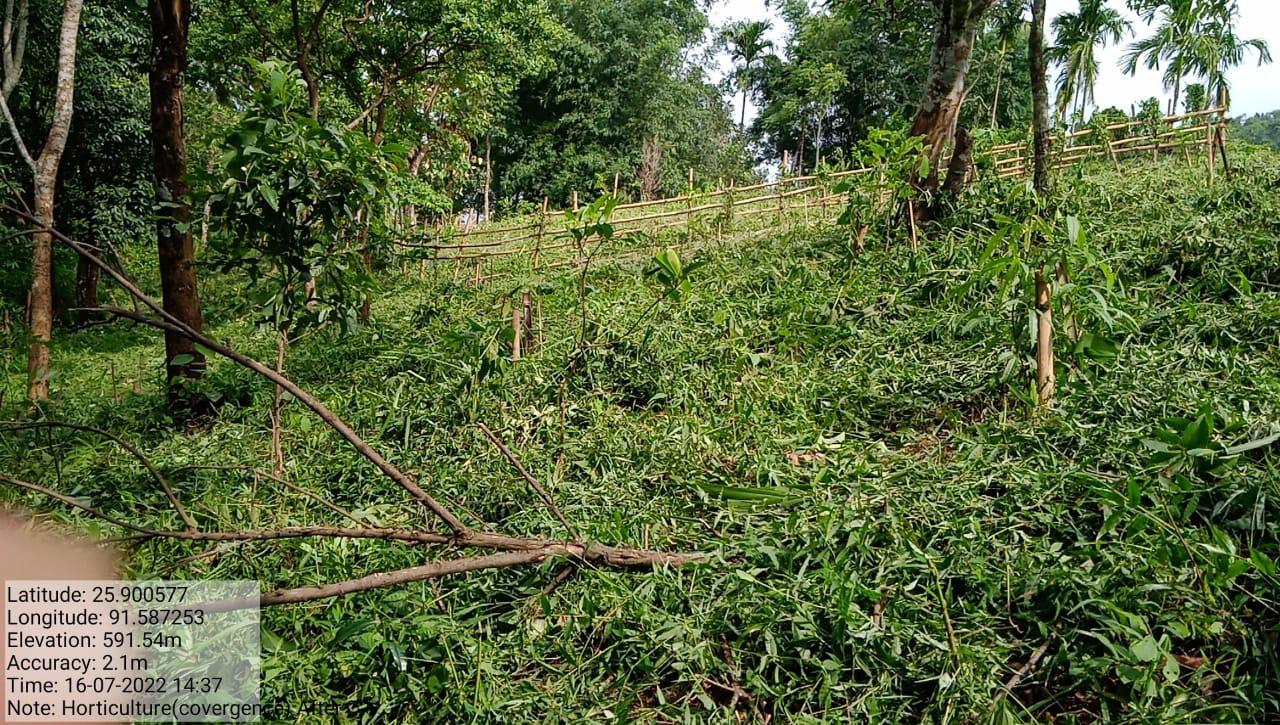

| NAME OF THE INTERVENTION | SITE NAME | TOTAL AMOUNT | DATE OF COMPLETION | WORK STATUS |
|---|---|---|---|---|
| BENCH TERRACING | LUM APALNGIANG | 2,42,000 | 20-Nov-21 | COMPLETED |

| NAME OF THE INTERVENTION | SITE NAME | TOTAL AMOUNT | DATE OF COMPLETION | WORK STATUS |
|---|---|---|---|---|
| FOREST FIRE LINE | SHONGPHUH, AMSIRANGKANG, TLUH UMIONG | 66,306 | 28.02. 2022 | COMPLETED |

| NAME OF THE INTERVENTION | SITE NAME | TOTAL AMOUNT | DATE OF COMPLETION | WORK STATUS |
|---|---|---|---|---|
| CONTOUR TRENCH | AMPALNGIANG | 86,403 | 24.03.2022 | COMPLETED |

| NAME OF THE INTERVENTION | SITE NAME | TOTAL AMOUNT | DATE OF COMPLETION | WORK STATUS |
|---|---|---|---|---|
| RENOVATION OF THE HEADWORK | Ampalangem | 2,15,000 | 01-May-22 | Completed |

| NAME OF THE INTERVENTION | SITE NAME | TOTAL AMOUNT | DATE OF COMPLETION | WORK STATUS |
|---|---|---|---|---|
| Agroforestry | Ampalangem | 1,07,971 | 27-june-22 | Completed |


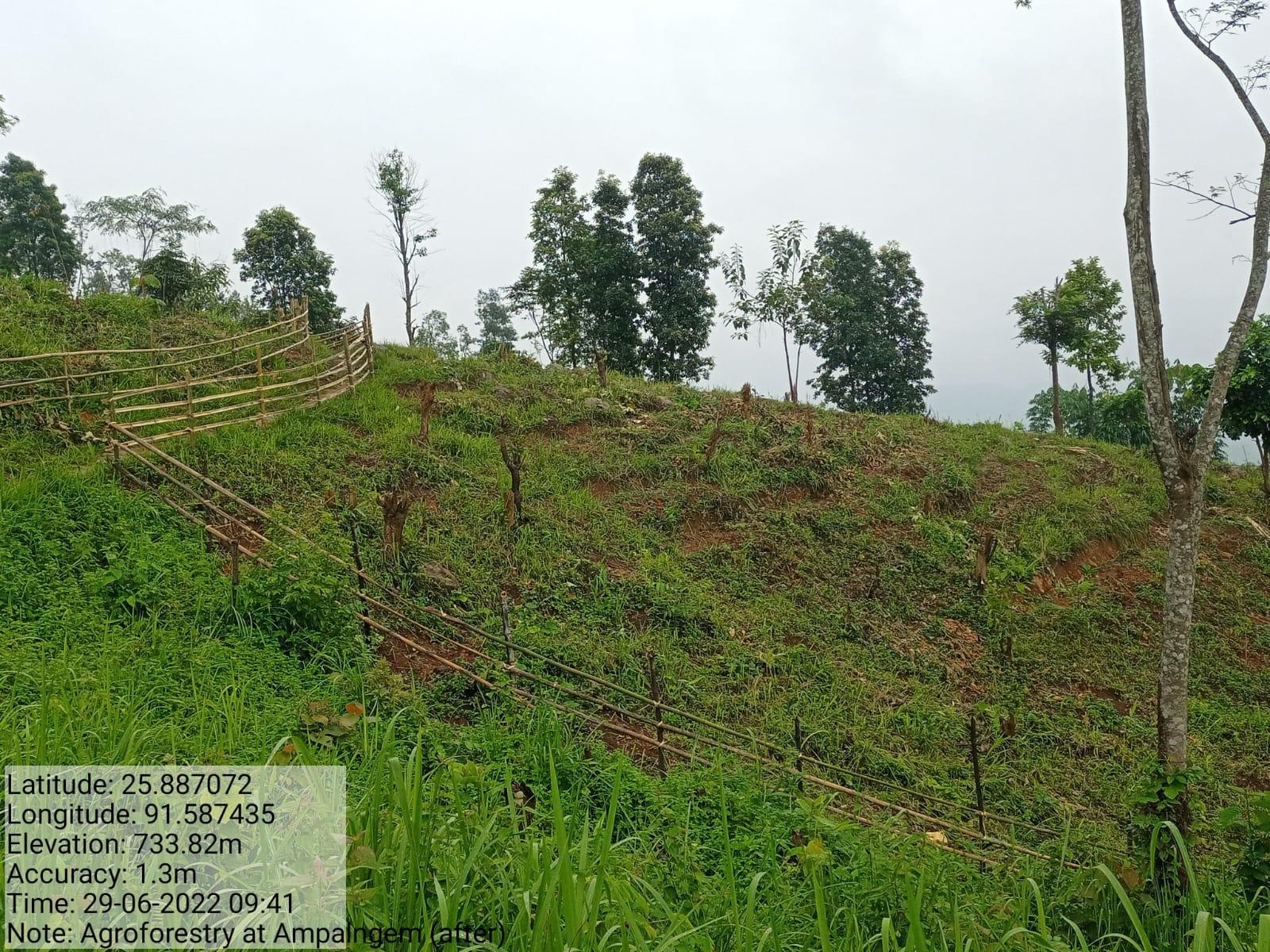
| NAME OF THE INTERVENTION | SITE NAME | TOTAL AMOUNT | DATE OF COMPLETION | WORK STATUS |
|---|---|---|---|---|
| Earthen bund cum bio fencing | Dongsmowknor | 5,00,000 | 18- jul-22 | Completed |

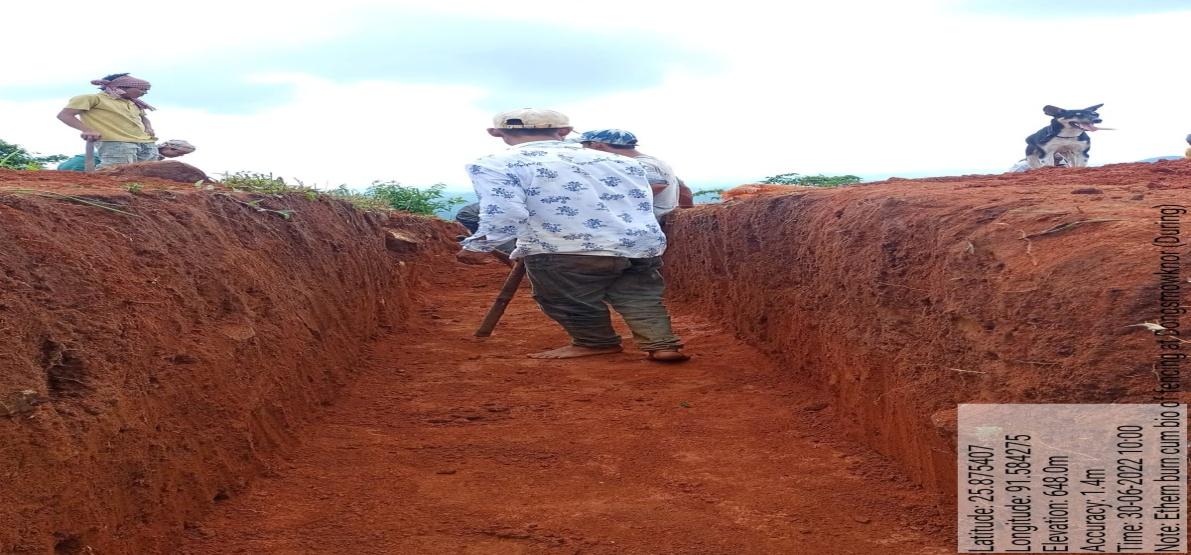

| NAME OF THE INTERVENTION | SITE NAME | TOTAL AMOUNT | WORK STATUS |
|---|---|---|---|
FMP Activities: 1. Nursery for Food Forestry (Sapling for the Existing Nursery) 2. Assisted natural regeneration in open forests (Contour Bund Cum Afforestation) 3. Community Forest Boundary Survey 4. in situ & Ex situ conservation of rare & endangered plants. 5. Fire control line 6. Enrichment Planting in forests blanks |
all under community land | 1,05,243 | Completed |
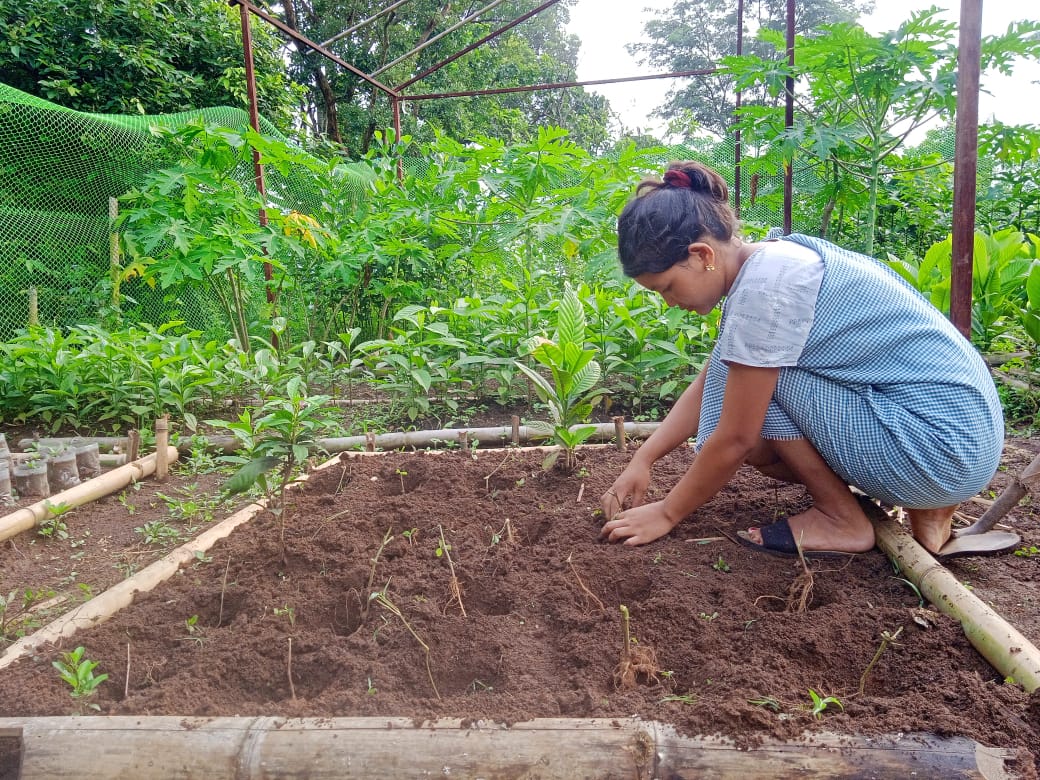


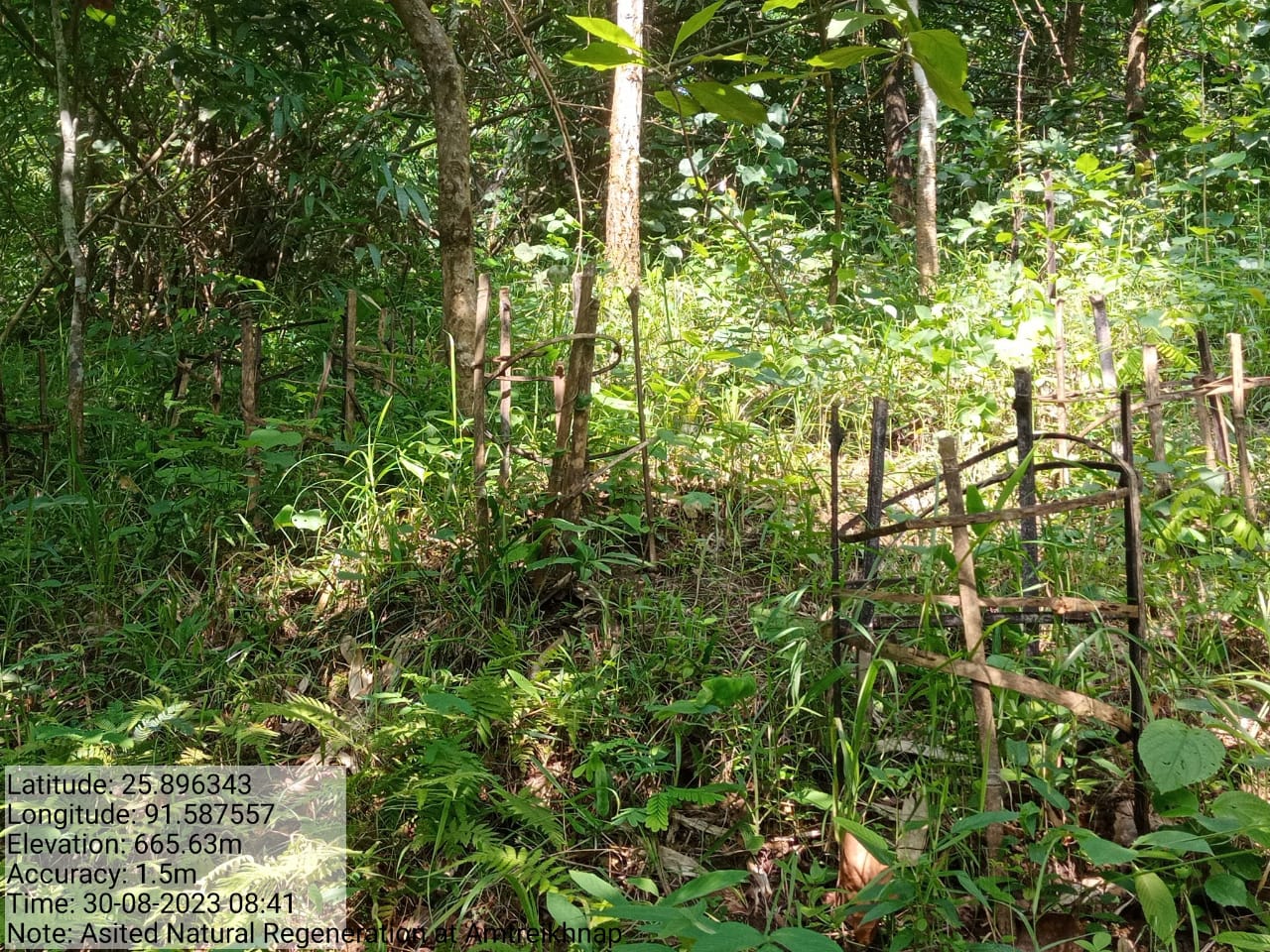

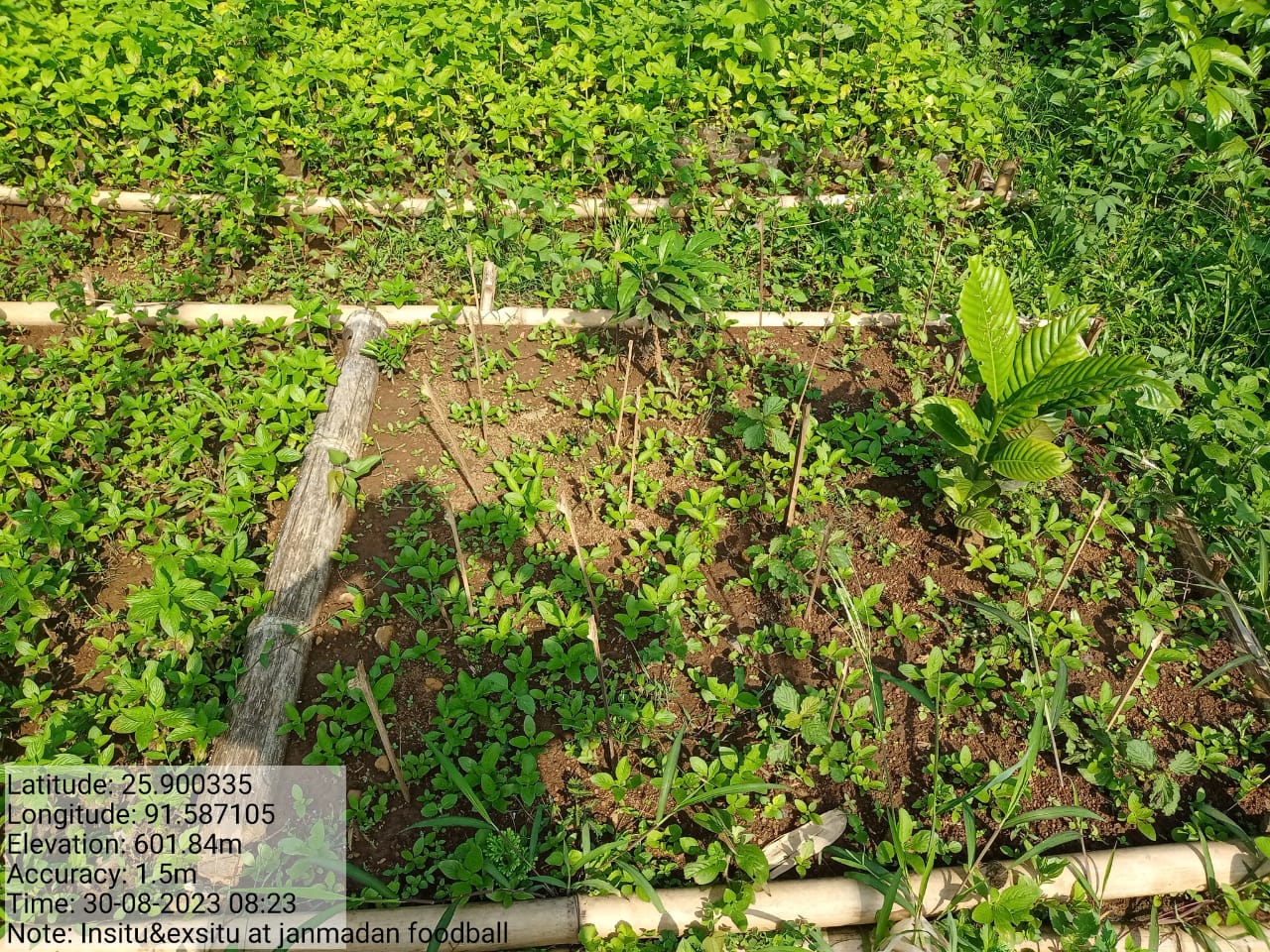
| Intervention | Site Name | Amount | Work Status |
|---|---|---|---|
Excess fund activities PA System Water System Solar light Dustbin |
community land | 48,848 | Completed |
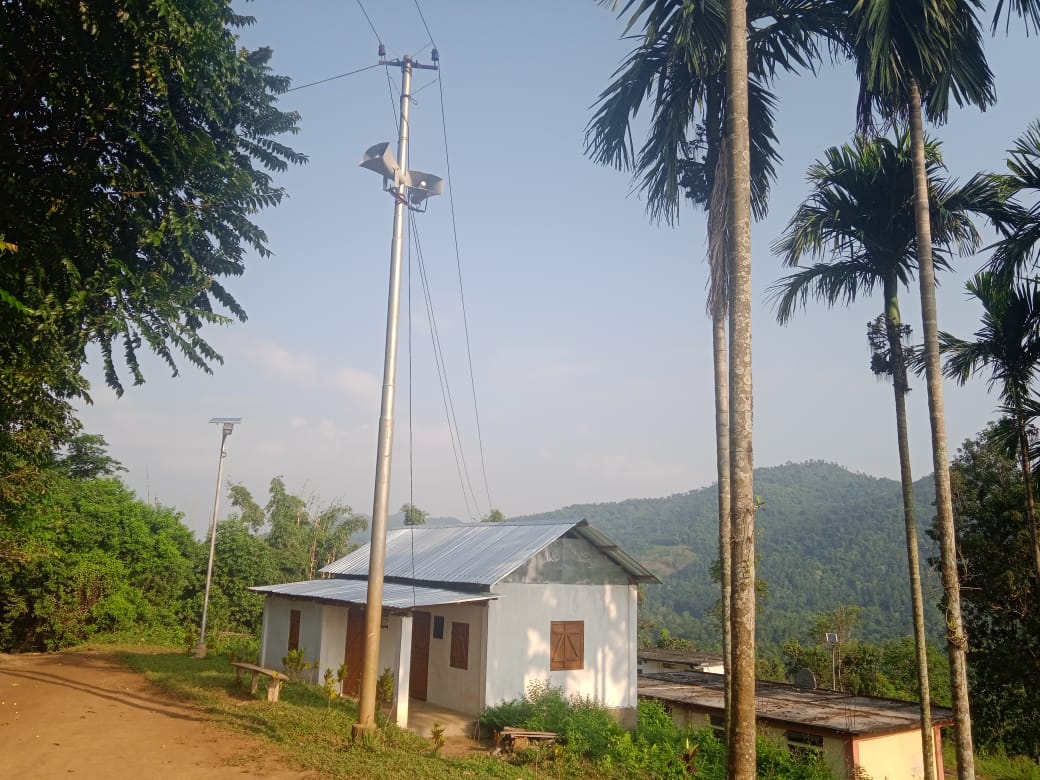


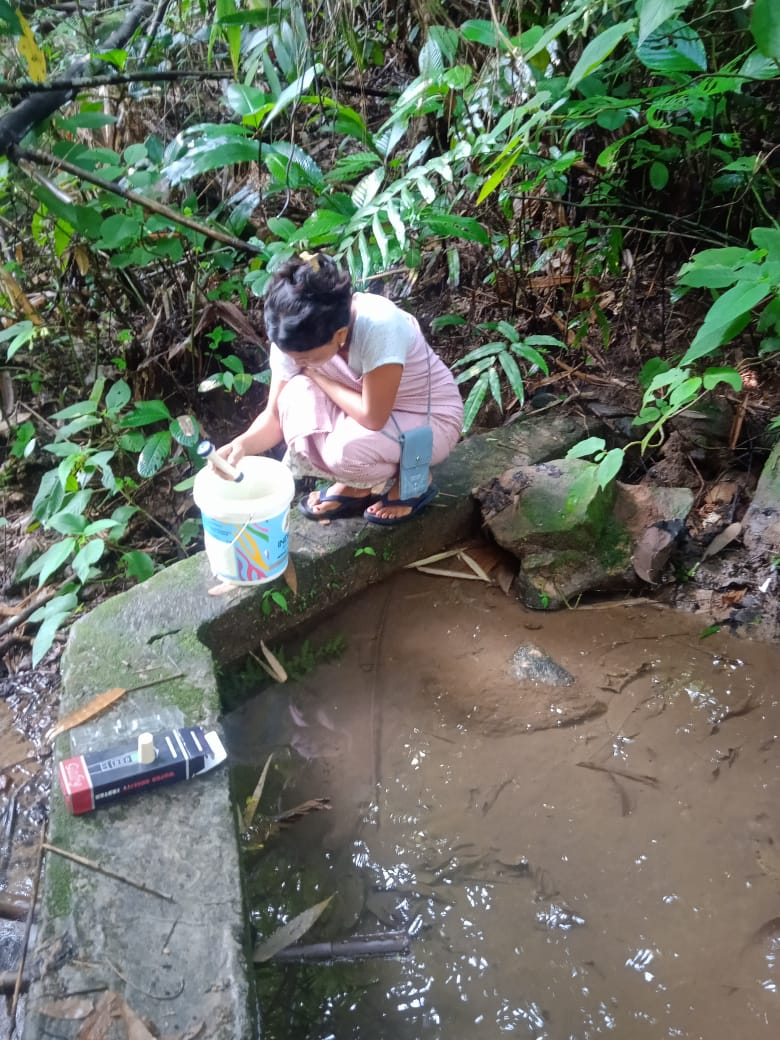
TESTIMONIALS
President- Retaincius Lapang
With the coming of this project in our village we get a lot of benefits ranging from cleanliness to the preservation of the environment. We were also able to make our own organic manure in various plantation activities and it has been progressing lately through every effort from the office as well as the community.
The changes before and after this project came is that before we lacked a lot in terms of water supply but now we get adequate supply through the check dam that was constructed in our community. With the coming of this project, we get to do better with what we are having and to strive further towards our commitment in strengthening and protecting the environment.
Secretary- Pynshaisngi Thangkhiew
This project comes with enormous benefits to everyone in the village. From learning to love Mother Nature to getting paid while working on various implementations, this project has it all catering to the needs of not just the environment but also to the local communities thereby serving as a means of livelihood to everyone. Being the Secretary, I get to focus work for the overall well being of the project as well as the village. This position has provided me with various knowledge, awareness and ideas that were not known to me and in this manner I get to share such insightful knowledge with the rest of the community.
VCF/ M&E- Banrilang Thangkhiew 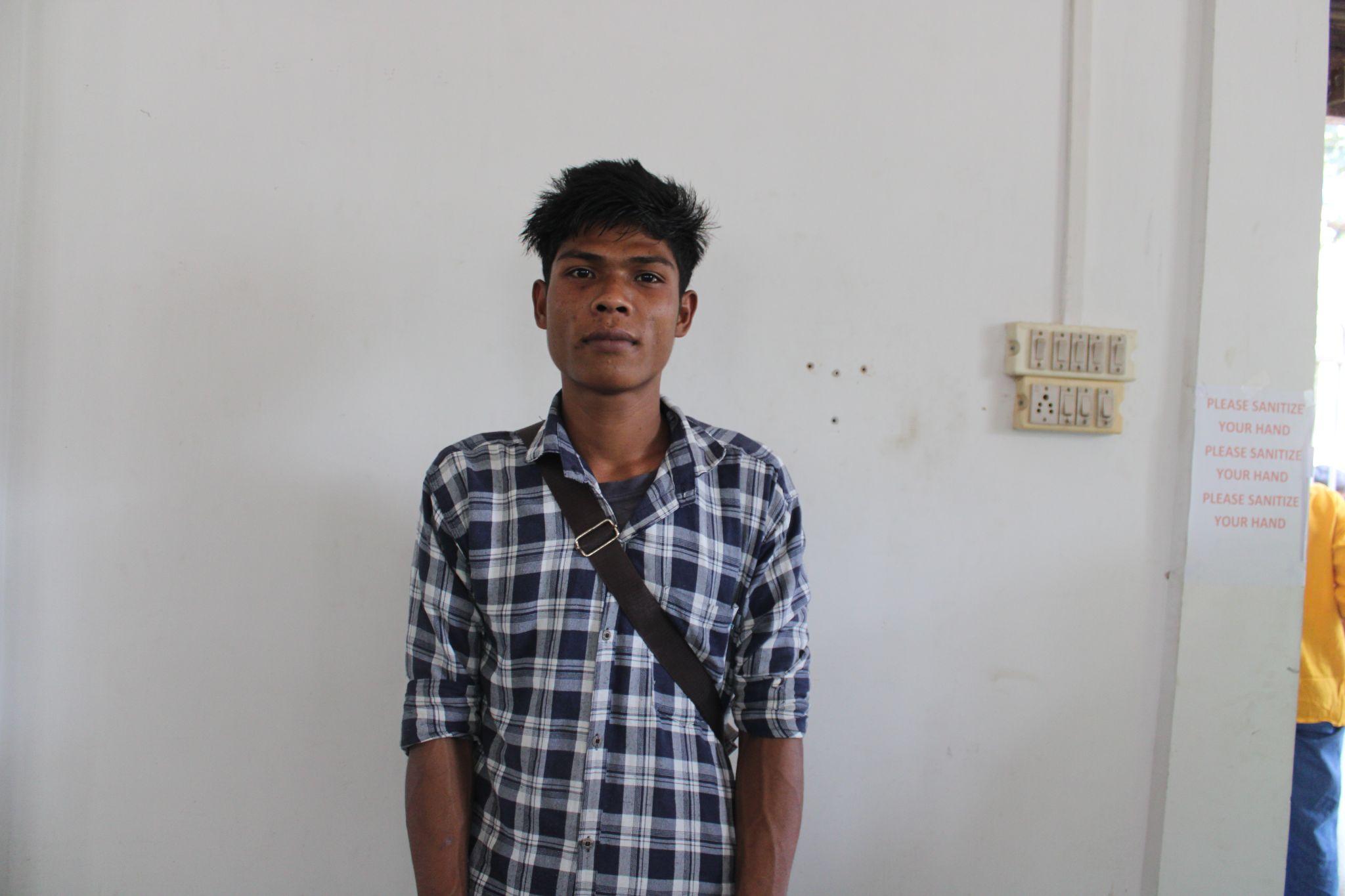
I took this part as a Monitoring & Evaluation facilitator as I was interested to work for the development of the village. My role revolves around the implementations that were implemented, to look after the duration of these activities, their progress and to make sure that these interventions serve the interest of not just the present generation but also those of the coming generations. This project has surely answered the needs and requirements of the village, especially to us VCFs who are working at the bottom level through their thorough and detailed training as well as exposure visits that were organized from time to time, making our job much easier and interesting to work.
VCF- Ithabashan Sangma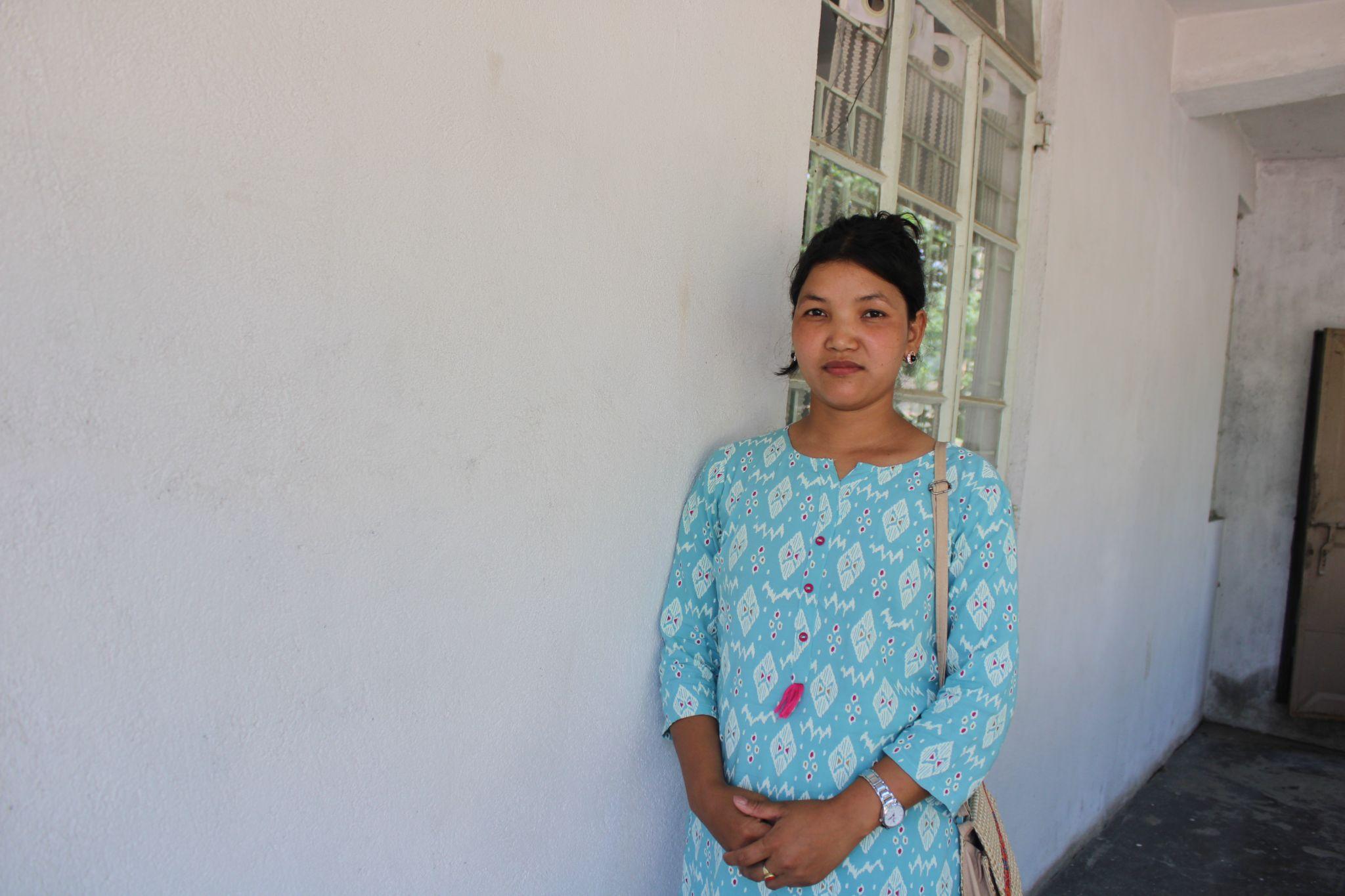
I took the role of a VCF in Social & Knowledge management with an intention to look for the overall betterment of the village, its cleanliness, to educate the community about the project and the initiative it has towards building and protecting our environment by working in harmony with nature. Through this project I have received various teachings mainly on NRM, but also on how to take care of the activities like Vermicompost, Nursery and most importantly their Exposure visits which help us to work on the field more efficiently. In all this, the sustainability of the works under this project is one that is very impressive and this will help us as a village to grow and prosper immensely among others. I hope that all the implementations of this Project will be maintained, protected and taken care of greatly so that the future generations will get to learn the NRM work and conservation that was taken up under this project.